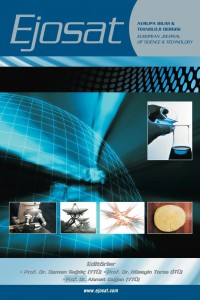Öz
EPDM (etilen propilen dien
monomer) önemli bir sentetik kauçuktur ve birçok farklı sektörde önemli
miktarlarda kullanılır. Kullanım miktarındaki artışa paralel olarak EPDM atığı
ortaya çıkmaktadır. Bu tür malzemeler, çapraz bağlanmalarından dolayı tekrar
eritilip tekrar işlenme ihtimaline sahip değildir. EPDM atıkları, genellikle,
ithal bazlı plastik endüstrisi için zaten önemli bir kayıp olup yakıt olarak
tüketilmektedir. EPDM kalıntılarının değerlendirilmesinin bir başka yöntemi,
bunları küçük boyutlara getirerek farklı polimerlere eklemektir. Bu çalışmanın
amacı atık EPDM tozlarının, polipropilen EPDM karışımlarının bükülme
özellikleri üzerindeki etkisini araştırmaktır. Dört farklı boyda (0-50, 50-75,
75-150 ve 150-300µ) öğütülmüş EPDM, ekstrüzyon yoluyla dört farklı oranında %
0, % 10, % 20, % 30 ve % 50 ile polipropilene eklendi. Bu karışımlara ayrıca %
1 oranında kaydırıcı ve % 0.2 oranında antioksidan ilave edildi. Test
numuneleri bu karışımlardan enjeksiyonlu kalıplama ile hazırlandı. Standartlara
göre hazırlanan numunelere eğilme ve HDT testi yapıldı.
Anahtar Kelimeler
Kaynakça
- Vahapoğlu V., Yüksel H. T. (2006). EPDM Sentetik Kauçuğu, Proceddings of 11th International Materials Symposium, Denizli, April 19–21 333 –337.
- Bismarck A., Baltazar-Y-jimenay A., Sarlkakis K., (2006). Green Composites on Panacea Socio-economic aspects of green materials. Environment, development and sustainability 8 (3), 445-463
- Wolcott, M. P.: (1996) Proceedings of the 30th Washington State University International Particleboard/Composites Materials Symposium, J. Appl. Polym. Sci., Pullman, WA; 37
- Aşık, M., (1997). Fındıkkabuklarının Değerlendirilmesi, Doktora Tezi İTÜ Kimya Müh. Böl., İstanbul
- Geng, Y.; Li, K.; Simonsen, J.: (2004) Effects of a Compatibilizer System on the Flexural Properties of Wood-Polyethylene Composites, J. Appl. Polym. Sci., 91 3667-3672
- Stark NM, Matuana LM, Clemons CM. (2004) Effect of processing method on surface and weathering characteristics of wood-flour/HDPE composites. J Appl Polym Sci; 93, 1021–1030.
- Dhakal, H.N., Zhang, Z.Y., Richardson, M.O.W., (2006). Effect of water absorption on the mechanical properties of hemp fibre reinforced unsaturated polyester composites, Composites Science and Technology, doi.org/10.1016/j.compscitech.2006.06.019
- Törmälä, P., Pääkkonen and Luoto, K., (1985). Injection molding and extrusion of composites of low-density polyethylene and plywood grindings, Journal of Applied Polymer Science, 30, 423-427.
- Gamstedt EK, Nygård P, Lindström M. (2007). Transfer of knowledge from papermaking to manufacture of composite materials. In: Proceedings of the 3rd wood fibre polymer composites international symposium, Bordeaux, 12 p.
- Xiao W. H., Huang S. O., Tao J.; (2004). Morphology Rheology and Mechanical Properties of Dynamically Cured EPDM/PP Blend: Effect of Curing Agent Dose Variation",Journal of Applied Polymer Science Vol. 92, 357–362.
- Jacob C., (2001). Bhowmick S.; Reycling of EPDM Waste. II. Replacement of Virgin Rubber by Ground EPDM Vulcanizate in EPDM/PP Thermoplastic Elastomerik Composition, Journal of Applied Polymer Science Vol.82,: 3304-3312.
- Çetin, C.; (2009). Lastik, Kauçuk, Poliüretan Geri Dönüşüm Teknolojisi, Kauçuk Derneği Dergisi Sayı: 35, 28-29.
Öz
EPDM (ethylene propylene
diene monomer) is an important synthetic rubber and is used in significant
quantities in many different sectors. In parallel with the increase in the
amount of usage, EPDM waste is emerging. Such materials do not have the
possibility of being melted and processed again due to their cross-linking.
EPDM waste is usually consumed in the form of fuel, which is already a
significant loss for the import-based plastic industry. Another method of
evaluation of EPDM residues is to add them to different polymers by bringing
them into small dimensions. The aim of this study is to investigate the effect
of waste EPDM powders on the bending properties of polypropylene EPDM mixtures.
Ground EPDM (GEPDM) with four different sizes (0-50, 50-75, 75-150 and
150-300µ) were added to polypropylene with four different weight ratios 0% 10%,
20%, 30% and 50% via extrusion method. These mixtures were also added with a 1%
slider and 0.2% antioxidant. Test samples were prepared by injection molding
from these mixtures. Bending and HDT tests were performed on the samples
prepared according to the standards.
Anahtar Kelimeler
Kaynakça
- Vahapoğlu V., Yüksel H. T. (2006). EPDM Sentetik Kauçuğu, Proceddings of 11th International Materials Symposium, Denizli, April 19–21 333 –337.
- Bismarck A., Baltazar-Y-jimenay A., Sarlkakis K., (2006). Green Composites on Panacea Socio-economic aspects of green materials. Environment, development and sustainability 8 (3), 445-463
- Wolcott, M. P.: (1996) Proceedings of the 30th Washington State University International Particleboard/Composites Materials Symposium, J. Appl. Polym. Sci., Pullman, WA; 37
- Aşık, M., (1997). Fındıkkabuklarının Değerlendirilmesi, Doktora Tezi İTÜ Kimya Müh. Böl., İstanbul
- Geng, Y.; Li, K.; Simonsen, J.: (2004) Effects of a Compatibilizer System on the Flexural Properties of Wood-Polyethylene Composites, J. Appl. Polym. Sci., 91 3667-3672
- Stark NM, Matuana LM, Clemons CM. (2004) Effect of processing method on surface and weathering characteristics of wood-flour/HDPE composites. J Appl Polym Sci; 93, 1021–1030.
- Dhakal, H.N., Zhang, Z.Y., Richardson, M.O.W., (2006). Effect of water absorption on the mechanical properties of hemp fibre reinforced unsaturated polyester composites, Composites Science and Technology, doi.org/10.1016/j.compscitech.2006.06.019
- Törmälä, P., Pääkkonen and Luoto, K., (1985). Injection molding and extrusion of composites of low-density polyethylene and plywood grindings, Journal of Applied Polymer Science, 30, 423-427.
- Gamstedt EK, Nygård P, Lindström M. (2007). Transfer of knowledge from papermaking to manufacture of composite materials. In: Proceedings of the 3rd wood fibre polymer composites international symposium, Bordeaux, 12 p.
- Xiao W. H., Huang S. O., Tao J.; (2004). Morphology Rheology and Mechanical Properties of Dynamically Cured EPDM/PP Blend: Effect of Curing Agent Dose Variation",Journal of Applied Polymer Science Vol. 92, 357–362.
- Jacob C., (2001). Bhowmick S.; Reycling of EPDM Waste. II. Replacement of Virgin Rubber by Ground EPDM Vulcanizate in EPDM/PP Thermoplastic Elastomerik Composition, Journal of Applied Polymer Science Vol.82,: 3304-3312.
- Çetin, C.; (2009). Lastik, Kauçuk, Poliüretan Geri Dönüşüm Teknolojisi, Kauçuk Derneği Dergisi Sayı: 35, 28-29.
Ayrıntılar
| Birincil Dil | Türkçe |
|---|---|
| Konular | Mühendislik |
| Bölüm | Araştırma Makalesi |
| Yazarlar | |
| Yayımlanma Tarihi | 31 Mart 2019 |
| Yayımlandığı Sayı | Yıl 2019 Sayı: 15 |

